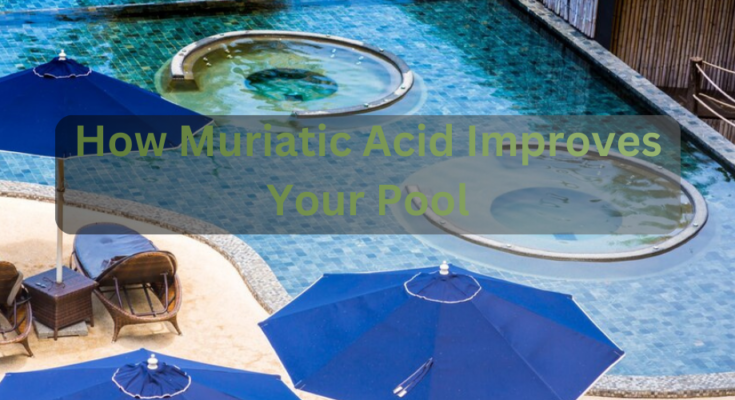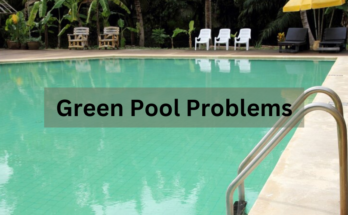Hydrochloric acid, sometimes referred to as muriatic acid, is a necessary tool for keeping your swimming pool’s pH at the right level. Keeping the water balanced is an important maintenance task that not only makes the pool clean and comfortable but also helps in preventing wear and tear on your pool’s surfaces. For instance, an unbalanced pH can lead to mineral deposits on the walls and floor, or even damage the concrete, causing thinning, cracks, and leaks. Additionally, as pH rises, it reduces the effectiveness of your sanitation method, making it harder to maintain a healthy pool environment.
Using muriatic acid is a common and effective tool for tasks like balancing alkalinity, lowering pH levels, and even cleaning cartridge filters. It’s an integral part of pool chemistry, helping to control chlorine efficiency and calcium hardness. Whether it’s for a personal pool or larger setups, this product plays a critical role in keeping your pool water balanced and extending its lifespan.
Understanding Muriatic Acid
Muriatic acid is one of the most common acids used for lowering the pH in your pool. While a true neutral pH is 7, pools should stay between 7.2 and 7.8, which is slightly basic. If your pool’s pH becomes higher than 7.8, it’s time to use a fastest-acting and affordable option like muriatic acid. This popular maintenance chemical is highly effective due to its strength, but being a strong acid means you need to be cautious and use proper protection. If you’re unsure about working with such chemicals, consider hiring a pool maintenance service to avoid the mess and stay safe.
Muriatic Acid and Pool Safety
When working with muriatic acid, staying safe requires careful planning and the use of proper precautions. The risk of exposure to this powerful acid means you should wear protective gear like waterproof and acid-resistant gloves, long sleeves, pants, and goggles—not just safety glasses—to guard against vapors that can burn your eyes or irritate your respiratory tract. Avoid breathing harmful fumes by wearing a respirator and ensuring the area is well-ventilated. Spills should be cleaned promptly to protect surfaces like concrete and other substances, and muriatic acid must be stored in a spill-proof container in a dark, temperature-controlled space to minimize risks.
Having plain water and baking soda on hand for emergencies is essential, as baking soda can neutralize spills and water helps wash affected areas. If you encounter any discomfort or symptoms, get medical help right once. It’s wise to have someone else nearby in case of problems or the need to contact medical services. With the right preparation, handling muriatic acid can be both safe and effective for maintaining your pool.
Why pH Is Important for Your Pool and How Muriatic Acid Can Help.
Maintaining the pH level in your pool water is crucial for both safety and effectiveness. When the pH is too acidic or too high, it can affect everything from chlorine efficiency to the overall clarity of the water. Your pool should have a pH between 7.2 and 7.8. If your pH falls below 7.2, your pool water is too acidic, and if it rises above 7.8, it can cause problems like scaling on waterline tiles and other surfaces. Environmental factors such as rainfall, outside temperature, and frequent pool usage can all affect your pH.
A chemical like as sodium bisulphate or muriatic acid can be used to rapidly return the pH of your pool to a level that is acceptable. While muriatic acid is more effective, sodium bisulfate is a safer, milder option. These pH reducers are commonly available at pool supply stores in powder form or liquid, and they help correct the pH imbalance to keep your pool in top condition. If you notice your pool water becoming cloudy or chlorine not working as well, these acids will help restore the balance, making it safer and more comfortable for swimming.
Testing Pool Chemistry
Before you add muriatic acid or any other chemicals, it’s essential to test your pool chemistry to maintain pH in saltwater pools. A simple test kit can help you measure pH and alkalinity levels, which determine the balance of your pool water. pH tells you how basic or acidic your pool is, while alkalinity shows how much the water resists acidification.
To get accurate results, use a water test kit that checks multiple parameters at once. Testing the water ensures you know exactly what adjustments are needed to maintain your pool. After testing, you’ll know if the pH balance is right and if muriatic acid is necessary to lower pH.
After making any pool adjustments, wait a few hours and test the water again. The pool filter should be running and water flow active for the best results. This ensures the added chemicals are working and that the pool water quality is trending in the right direction.
If you need to make more changes, continue testing and adjusting. It’s important to ensure the water is safe for pool swimmers and that the pool care is effective. Patience is key, as sometimes it takes time for muriatic acid and other chemicals to fully take effect.
Determining the Amount Needed
When you need to add muriatic acid to your pool, it’s crucial to calculate the precise amount needed. First, test the pH of your pool and determine the volume of water by using the equation: length x width x depth x 7.5 = gallons. The ideal pH of your pool should be between 7.4-7.6, and the alkalinity should range from 100-150 ppm, with 125 ppm being optimal.
Next, using the correct measurements, you can calculate how much acid is required. If you’re unsure, you can use an online calculator to help determine the amount of acid needed. Keep in mind that these calculators provide an estimate, so it’s always a good idea to double-check your results.
After adding the muriatic acid, it’s important to allow the water circulation to mix the chemicals properly. Let it circulate for a few hours and then test the water again to ensure that the pH and alkalinity levels are within the desired range. This step ensures that your pool is safe and balanced for swimmers.
Application Methods
When using muriatic acid in your pool, there are a couple of methods to apply it. The first method, broadcasting, involves spreading the acid over a large area of the pool. This helps the acid dilute and mix into the pool water, but it can be tricky since muriatic acid is heavy and may end up sinking to the bottom without mixing properly.
An alternative to broadcasting is pre-dilution. This method involves mixing muriatic acid with water in a 5-gallon bucket at an ideal ratio of 10:1—water first, then add acid. This diluted mixture is easier to distribute and poses fewer risks of acidification or damage to the pool equipment and concrete surfaces.
To ensure the acid works effectively, it’s important to add it in a high-flow area of your pool, like the deepest portion. The movement of the water here helps with mixing and protects both the pool condition and concrete lining. Make sure to test your pool’s pH and acid levels after making adjustments to ensure you maintain the correct pH adjustment for optimal pool chemistry and safety.
Step-by-Step Instructions
We’ve covered most of the steps, but here’s a quick guide to help you know exactly what to do.
-
Test pH of your pool using a test kit in multiple areas.
-
Calculate the necessary muriatic acid by measuring length, width, and depth, then multiplying by 7.5 to find gallons of water.
-
Use an online calculator to determine the ideal range for your pH.
-
Gather protective equipment, including clothing, water, baking soda, acid-resistant gloves, and air-tight goggles with a good seal.
-
Ensure your pool is circulating water and check the vents before proceeding.
-
Dilute the required amount of muriatic acid in a 5-gallon plastic bucket, or prepare to broadcast it directly.
-
Pour the muriatic acid solution into the pool and allow it to mix well with the water.
-
Wait several hours, then retest the pH and make any necessary adjustments using the same process.
Testing and Monitoring
Regular testing is essential to manage your pool chemistry and ensure the chemical balance is correct. To avoid significant problems, you should make frequent adjustments and monitor the results carefully.
Environmental factors like weather, precipitation, and debris can affect your pool. Rainwater often alters pH, so recheck your pool chemistry after storms to make maintenance easier in the long term.
Use precise testing and re-testing methods to maintain a balance close to 100% accuracy. With consistent long-term maintenance, you can ensure a safe swimming experience free of chemical imbalances.
Clean-up and Disposal
Handling muriatic acid safely is critical, especially during clean-up. Never rinse or wash muriatic acid containers down the drain, as the chemical can damage plumbing, the sewer system, and other materials. Such practices can lead to significant damage, making proper disposal essential.
Instead, take empty muriatic acid containers, leftover muriatic acid solutions, and mixed muriatic acid solutions to a hazardous waste disposal facility. This ensures they are discarded safely without harm. Always follow local guidelines when it’s time to get rid of them.
Conclusion
Using muriatic acid for your pool is essential for proper maintenance, but it requires following strict safety precautions to avoid any dangerous outcomes. By staying careful and making necessary adjustments, you can keep your swimming pool clean, water balanced, and its chemistry in check. This not only keeps the pool balanced but also reduces time spent scrubbing algae, giving you more time to enjoy. If you have any concerns, consult a local pool professional to stay up to date and ensure you use less muriatic acid over time.
FAQS
Will muriatic acid clear up a pool?
Muriatic acid can help clear up a pool by reducing high pH levels, which prevents water cloudiness, ineffective chlorine, and scale formation. Its corrosive properties are useful for removing stains, scale, and calcium deposits from pool surfaces and equipment, making the pool water clearer and improving overall water quality.
How much muriatic acid for a 10,000 gallon pool?
pH Adjustment Table for Muriatic Acid
How long to run a pool pump after adding muriatic acid?
After adding muriatic acid to your pool, it’s important to run the pump for at least half an hour to allow the acid to properly mix and diffuse throughout the pool water. If you want to increase the pH further, you can continue running the pump or use an aerator or air stone to oxygenate the water and help speed up the process.
What are the disadvantages of muriatic acid?
Health Effects
Muriatic acid can be dangerous, especially with skin contact, as it may cause severe burns and lead to dermatitis after prolonged exposure. It is also harmful if swallowed and can cause irreversible damage to the mucous membranes. Additionally, repeated or prolonged exposure to corrosive materials or fumes may cause gastrointestinal disturbances, making it crucial to handle it carefully to avoid health risks.
Does muriatic acid get rid of algae?
Muriatic acid is an effective and affordable solution for maintaining your pool. When used correctly, it helps to clean the pool and keep it free from algae and other contaminants. However, it’s essential to take proper safety precautions when handling the acid and always wear the right protective gear to avoid harm.



